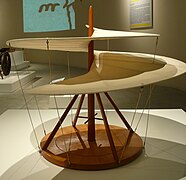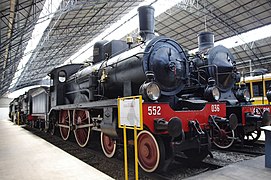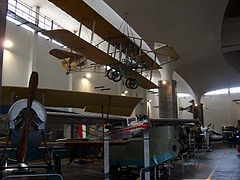Museo nazionale della scienza e della tecnologia Leonardo da Vinci
The Museo nazionale della scienza e della tecnologia Leonardo da Vinci is a science and technology museum in Milan . It is named after the polymath Leonardo da Vinci . With around 16,000 objects on display, it is the largest museum of its kind in Italy . The main building on Via San Vittore was once a monastery . The museum can be reached via the Sant'Ambrogio stop on metro line 2 .
history
On the occasion of the world exhibition in Milan in 1906, the engineer and industrialist Guido Ucelli proposed the establishment of a technical museum. It was not until 1930 that the city of Milan, at the suggestion of the government and the National Research Council CNR , set up a commission in Rome to create a Museo delle arti e delle industrie . The chairman, Guido Ucelli, did not always agree with the fascist rulers regarding the museum concept ; the following year, CNR President Guglielmo Marconi approved the Commission's plans, but initially they were not implemented. After 1942, the Foundation Fondazione Museo Nazionale della Tecnica e dell'industria was founded, managed Guido Ucelli 1947, devastated by Allied bombs former monastery San Vittore al Corpo to get to the museum. In the same year the foundation was transformed into an institution under public law called the Museo nazionale della scienza e della tecnica and named after Leonardo da Vinci in 1952. After extensive restorations and alterations, the museum was opened on February 15, 1953 with a Leonardo exhibition; Prime Minister Alcide De Gasperi was among the guests of honor . In the following 15 years, the museum was expanded in a south-easterly direction (towards Via Olona ): a new railway exhibition was built on the site of the first hall of the aviation department, and to the south-east of it a new hall for the aviation and maritime department, when it was opened in the year In 1964 President Antonio Segni was also present. The latter received a lunar rock fragment from the Taurus-Littrow valley from US President Richard Nixon for its space exhibition in 1973 .
In the didactic area, the museum set up a training center for teachers in 1955, in 1970 the offer was improved with museum tours and in 1993 the first of today's 13 interactive museum areas opened . In this context, the specialist library and archive as well as the center for informal education and research founded in 2009 are also important.
In 1999 the museum was converted from a public law institution into a private law foundation. The Italian Ministries of Education and Cultural Assets are the founders, while the main sponsors are the Lombardy region , the city of Milan and the Milan Chamber of Commerce and Industry . The most important universities in the metropolitan city of Milan are represented on the scientific advisory board .
With regard to developments after the turn of the millennium, the following are worth mentioning: the takeover of a submarine and the establishment of interactive exhibitions in the fields of genetics , biotechnology and robotics in 2005, the opening of the renovated auditorium and the helicopter exhibition in 2007, the opening of the new one Museum shop MUST-Shop (2009), the exhibitions on nutrition and nanotechnology (2010) and the new space exhibition (2014).
The main building of the museum was originally a Benedictine convent , which was taken over by the Olivetans in the 16th century and expanded into a larger monastery complex, including the new building of the Church of San Vittore al Corpo . During the Napoleonic period , the monastery was converted into a military hospital until 1808 and then used as a barracks until the Second World War . The multiple renovations, the Allied air raids on Milan in 1943, the subsequent use of the ruin as a quarry and further damage from atmospheric influences meant that not much was left of the once impressive monastery. It was rebuilt as a museum from 1947 according to plans by the architect Piero Portaluppi by the construction companies Cerutti and Bertani.
Collections
The aim of the museum is to present scientific findings and their practical application. The focus is on the 19th and 20th centuries, with a special focus on scientific and technical developments in Italy. Means of transport , energy production , the steel industry , telecommunications and information technology are of greater importance . Apart from that, the studies of Leonardo da Vinci play a special role: the museum has the world's largest collection of models of apparatus that were recreated on the basis of Leonardo's plans or sketches.
The museum covers an area of around 50,000 square meters, 33,000 of which are covered. The exhibition areas add up to 25,000 m². There are no branch offices. Organizationally, the museum is divided into seven departments: Art and Science, Communication, Nutrition, Materials Science and Technology , Energy, Transport, Galleria Leonardo da Vinci .
The most important exhibits of these departments include: the first submarine built in Italy after the Second World War, Enrico Toti , which served the Italian Navy from 1968 to 1997 and was towed from its station in Augusta (Sicily) to the inland port of Cremona in 2001 and then did not get to the museum by land until August 2005; the steam turbine to generate electricity Regina Margherita from 1895; the UA1 detector at CERN , developed under the direction of Carlo Rubbia ; the P101 from Olivetti, the world's first freely programmable pocket calculator; the Sisson telescope , built in 1774 and installed in the Osservatorio Astronomico di Brera ; the prototype of the magnetic detector with which Guglielmo Marconi carried out experiments on messaging in 1902; the navigation bridge , the ballroom and some cabins of the transatlantic liner Conte Biancamano ; a model of the experimental helicopter tested by Enrico Forlanini in 1877 and the astrarium , a replica of an astronomical clock completed by Giovanni de Dondi in 1364 .
See also
Web links
- Official website (Italian, English)
Coordinates: 45 ° 27 ′ 46 ″ N , 9 ° 10 ′ 15 ″ E




